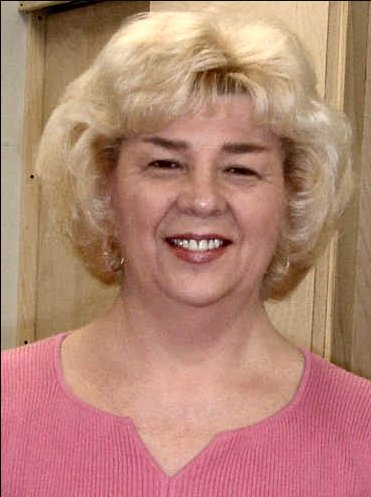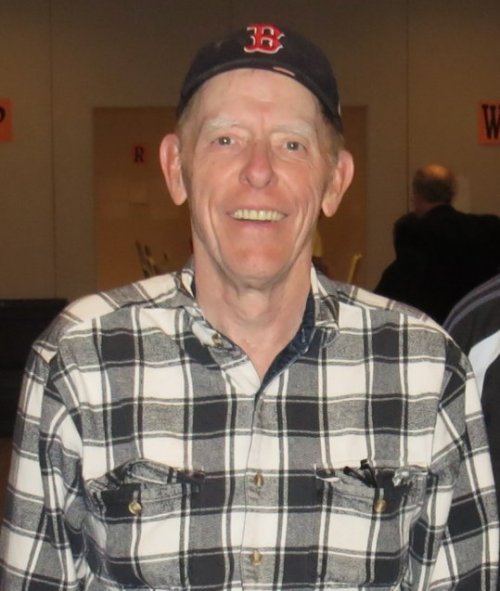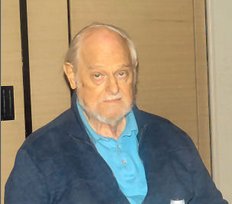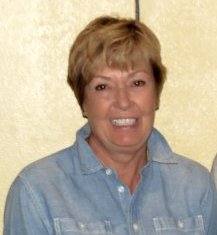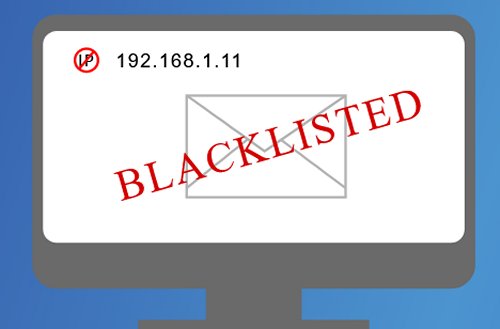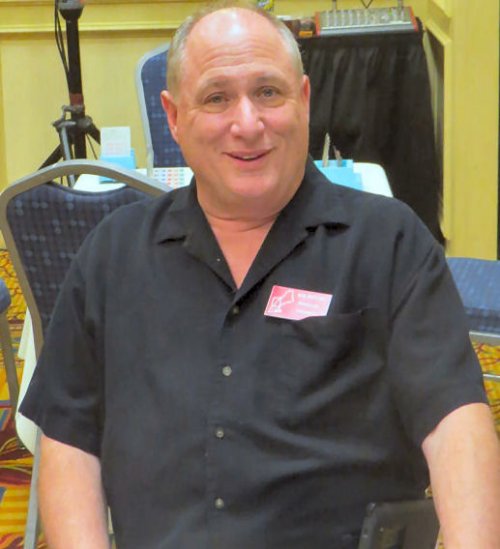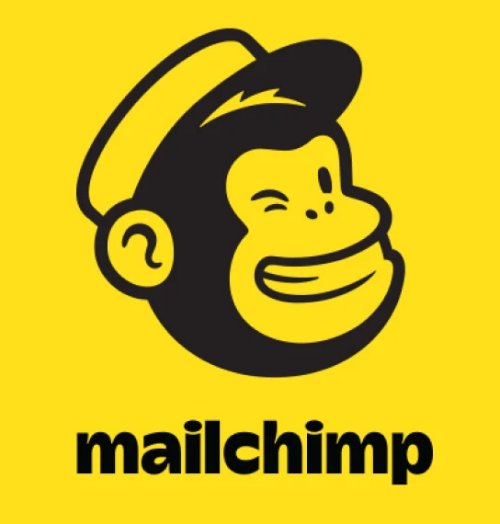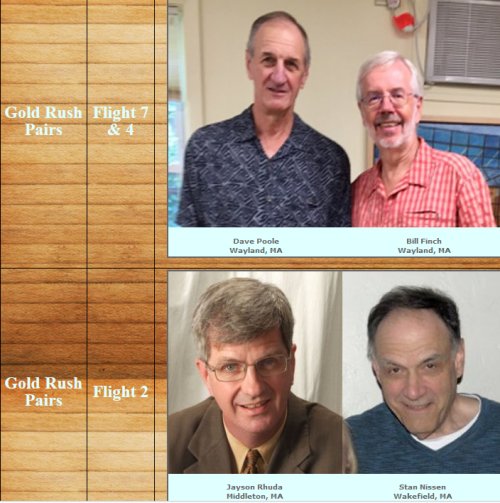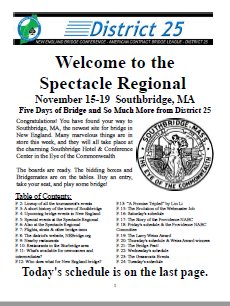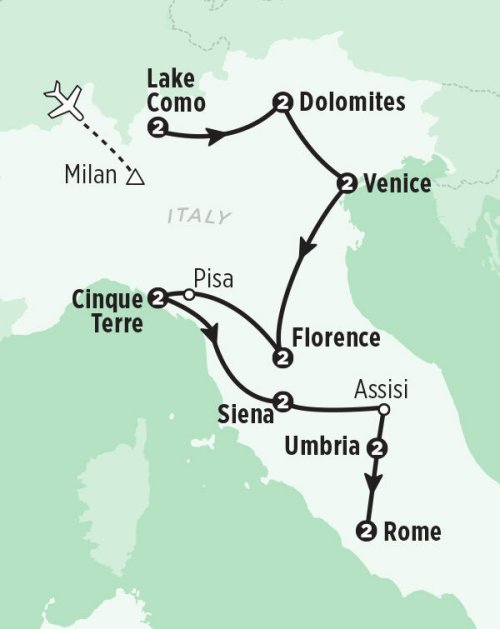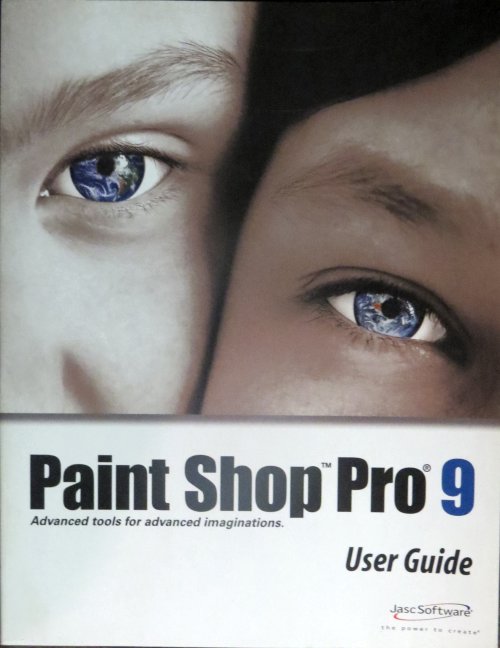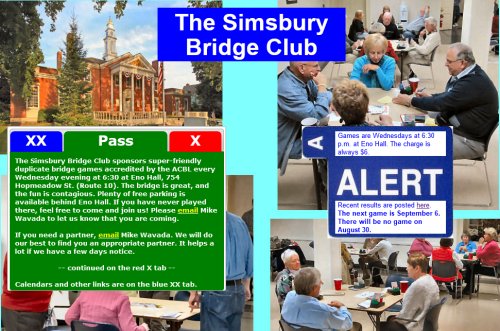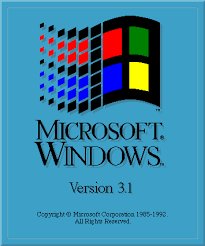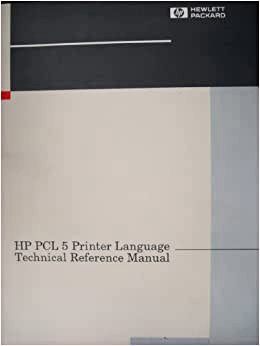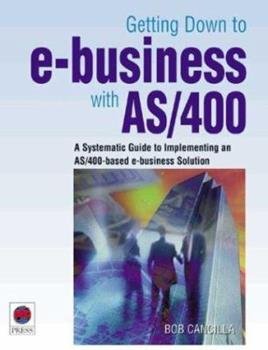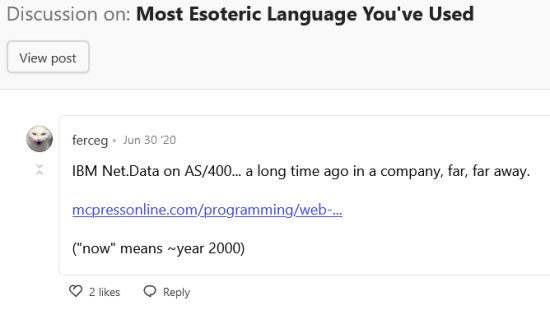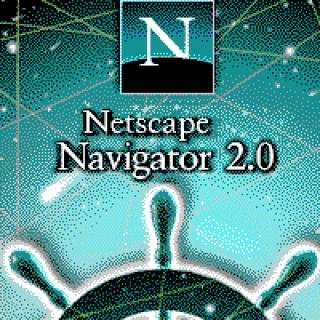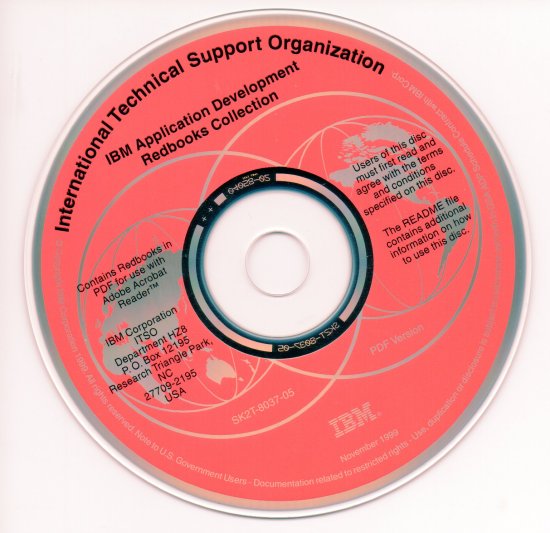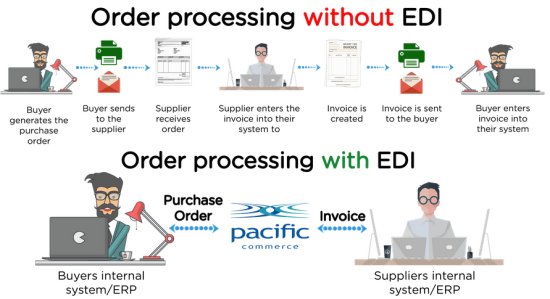Webmaster, database, email, comm comm, bulletin. Continue reading
2012 was long before “ACBL Live Results”1 made it easy for bridge players to find out within an hour or so the results of tournaments.Late in that year I saw a notice on the NEBridge.org2 home page that District 25 was looking for someone to post on the website the results from its tournaments. It asked interested players to contact the president of the New England Bridge Conference (NEBC), Ausra Geaski. I did, and after a short training session from Bob Bertoni, who owned and operated Megaherz Computer, the company that designed and implemented the website, I took over the job.
On the evening of each day of the 2013 Knockout Regional in Cromwell I posted the results. The tournament director sent me on text file for each event. I amalgamated them into one large file text file. I made an HTML file that had an index at the top with one line linked to the anchor for each event that I had inserted at the top of the appropriate text. It was HTML 101, not rocket science.
Bob thought that I had done a good job in getting the results posted promptly. He told me that someone who was webmaster at one of the other units had tried to do it at a previous tournament and had made a big mess.
I subsequently told Ausra, whom I occasionally saw at the Hartford Bridge Club3 (HBC). that I was willing and able to do more. Shortly thereafter another notice was posted on NEBridge.org. This one said that the district needed a webmaster. Bill Braucher was resigning from the post that he had held for seven years. I let Ausra know that I thought that I could do it. I also told her about my own website, Wavada.org (which was introduced here), but I don’t think that anyone ever checked it out.
One evening at a tournament Bob spent about an hour with me explaining how the district’s website was structured and how the built-in page editor worked. During this session he discovered that I already knew HTML, JavaScript, and CSS.4 He exclaimed, “Oh, you can code! You won’t have any trouble with this.”
A little later we realized that we had something else in common. Bob had attended Boston College on a debate scholarship.5 His coach was Tuna Snider, whom I knew fairly well. In the end Bob offered me the webmaster job at the same salary that Bill had earned.6 I countered with a demand for a 75% raise, and we settled on 50%.
The bridge world was very different then. The district’s website was its primary method of communicating with its members. It did not publish a newsletter, and it had no program for using email. For the most part postcards and flyers were snail-mailed to the clubs. The district relied on their owner/managers to pass the information on to the players. The method was fairly expensive and totally unreliable.
Furthermore, the webmaster was not allowed to post any material unless the website editor, Allan Clamage7, had checked it for style and errors. Allan also taught me about standards that the district had established to govern the decisions. For example, the website never published an obituary or promoted any unit’s tournaments or other events.
The Website Committee (Allan, Bob, District Director Rich DeMartino, and myself) had a strategy meeting during one of the lunch breaks at every tournament. I don’t remember much that transpired at these meeting, but the other members mostly endorsed my ideas for improving the website. After three or four of these meetings Rich declared that we seemed to know what we were doing and disbanded the committee. At about the same time Allan began to review what I posted only after the fact. I considered that show of trust as a great compliment. I only embarrassed him a few times, and he never got angry at me.
My main goal was to attract more eyeballs to the site. Expert players Harold Feldheim and Jay Stiefel allowed me to post articles that they had written for The Kibitzer, the newsletter of the Connecticut Bridge Association (CBA). I also received material from Frank Hacker, Steve Rzewski, Bill Braucher, and a few others. I began writing The View from B-Low under my nom de plume, Single Session Swiss8. After each tournament the webpage for The View whimsically recounted my own completely inexpert experiences. Most were true; a few were fish stories. Most of those articles still exist. The index to them is available here.
Database Manager: I remember that during one of my conversations with Allan, I exclaimed, “We don’t know who our players are!” He disagreed. He then showed me how he downloaded csv9 files of the entire ACBL roster every month, and he arranged for the ACBL to allow me to do the same. Allan used spreadsheets, but I undertook the major task of designing a MySQL database for use by the district and myself. At the time I wasn’t quite sure what I would do with the information, but I knew that we needed it.
I maintained two copies of the database, one on my local hard drive and one on the Wavada.org website that I had purchased from iPower so that I could share my travel journals with friends, family, and fellow travelers.
The database’s primary table had one record per player. Every table in any database should have a “key”—a field that uniquely identifies the record and cannot be changed. On the player table the key was the seven-digit ACBL number. Using it as the key would be a small problem if I wished to add records for non-ACBL members. Fortunately, if that ever happened, I could assign them a bogus number less than 1000000. The ACBL never used those numbers.
When a new roster was released I updated both the local and remote copies of the players table using scripts that I wrote in php. At first I did this only for currently active players in New England, but after a few months I decided to expand it to cover all of North America. The script that updated the players table also wrote records on a history table that contained each player’s point total at the time that the roster was posted.
One of my jobs as webmaster was to post a list every month of the New England players who had advanced in rank during the month. I decided to maintain a sub-table for these advancements using the file that was sent to me by the ACBL.
I soon realized that what I really wanted to know was who was attending the tournaments in New England. I knew that the results posted on the district’s website as well as on the websites of the units listed all players in attendance. There were two major difficulties: 1) the ACBL numbers were not on the lists; 2) the formats were not consistent. It was a big pain, but I eventually came up with scripts that could handle nearly all of the entries on all of the lists.It wasn’t close to perfect, but it was much better than nothing. I was convinced that it was worth the effort.
I created two sub-tables for attendance: one for players whose ACBL numbers I was able to deduce from the name and town on the list and one for the others. The biggest problem was people with more than one address. The second-biggest problem was people who changed their names. I figured out ways to handle these problems, but they were labor-intensive and introduced the possibility of mistakes.
I also went through the same process for the three NABC tournaments that were run every year. Those files were much larger. It took me a day or more to process each one. It was very important to do them promptly. If even a month elapsed, a lot of addresses changed.
Sending emails: Eventually, I wanted to use the database to send emails promoting the district’s tournaments. The first problem was that the emails on the ACBL’s database were incomplete. I reached out to my acquaintances throughout the district and came up with correct email addresses for at least half of the ones that were missing. I also went through the wooden box containing index cards with member data at the HBC and found a few there. To make sure that my good addresses were not overridden by the ACBL’s blank, confidential, or wrong addresses, I added a field to the player’s table for the source of the email and changed the php script so that it only used the email address on the roster if the previous source was “ACBL”.
The second problem was that I had no authority and no budget for anything like this. At the time District 25’s president, Mark Aquino, had created a “B’s Needs Committee” to address the problems that lower-level players (like myself) confronted when their masterpoints exceeded the 750-point maximum for the “Gold Rush” games. Mark attended some of the meetings. I told the committee about the database that I had created, and I mentioned that I would like to send emails to promote the events sponsored by District 25. I was very pleased when Mark said, “Go for it!”
The great thing about php was that it was—even in those days—thoroughly documented on the Internet. I discovered a way of sending emails through php. My first project was to promote the 2014 Senior Regional/Cape Cod Sectional in Hyannis, MA. The chairperson was one of my partners, Ginny Farber (then Ginny Iannini), who was introduced here.
I sent the emails to all members of District 25 and to anyone who, according to the attendance table on the database, had attended a recent tournament in New England or a national tournament. I knew that I had to be careful about being considered a spammer, and so I stated quite clearly in the email that anyone who wished to be removed from the list should reply to the email with that indication, and I would take care of it. The players table had an “OK to email?” field. I never mailed to anyone who had asked to be removed, and I was scrupulous about keeping this designation up to date..
The emails were very well received, and the attendance at the tournament exceeded expectations. The chairperson of the next event, the Summer Regional in Nashua, NH, was Sarah Widhu. She asked me to promote that event, and I did so. It was also well received, and the attendance was quite good. I was definitely on to something.
Email problems: The php script that I executed on my Wavada.org account was not completely fool-proof. Every so often it would send up to fifteen copies of the email to one person. This was, to put it mildly, quite annoying. I contacted iPower about it. Because I was unable to reproduce the problem for them, they could not solve it.
This problem was completely dwarfed by another issue that raised its ugly head shortly thereafter. None of the emails went out! Once again I contacted iPower. It took several weeks, and they never told me what they did, but the support team somehow fixed this.
However, after a few successful executions, the problem appeared again. After several weeks of interchanges with iPower support, I was finally informed that my account had been black-listed as a spammer by someone. Therefore, the iPower email server did not send out my emails.
I used the one phone call that I was allowed to tell Bob Bertoni that I was in email jail, and I asked if he could bail me out. He did some research and eventually negotiated a contract with MailChimp, a company that specialized in sending mass emails for businesses and non-profits, for the purchase of two million “credits” for emails for only $2500. The Executive Committee approved the appropriation. From that point on I never tried to send emails directly from iPower.
MailChimp: I set up an account on MailChimp with a user ID of Guastafeste, which is the Italian term for party-pooper. I taught myself how to use the software to create the lists and the emails themselves. For the first few years the account was allowed to create as many lists and emails as we wanted. I created a new list for each email until MailChimp prohibited me from creating any additional lists.
I generally sent out the first set of emails five weeks before the event. A second set would be sent two weeks later. Each set would be devoted to a group based on geography, masterpoints, and/or tournament attendance. The content sent to each group would differ, at least a little.
Because I was accustomed to composing my emails in HTML, I always used the “Code your own” template. I always wrote the code for the emails in UltraEdit on my PC and pasted the HTML code into the editing window on MailChimp. Te program would immediately display the way that the email would look in the window on the left side of the screen. This method allowed me to position and size images exactly. It also allowed for the use of tables and almost anything else that could be done on a webpage. An unanticipated benefit was that if someone who needed to promote something had sent me an email that was already formatted, I could extract the HTML code, tweak it a little, and then paste it into the HTML editing window.
I reported one bug that I found in this process. If I tried to change the color (or anything else) for part of a word, MailChimp inserted a space between the two parts. The example was GOLDmother, which MailChimp changed to GOLD mother. MailChimp refused to fix this obvious problem. By the way, it was not easy to get WordPress. which is the product used for these blogs, to produce this effect either.
The oldest HTML file that I found in the MailChimp folder on my PC was dated July of 2015. I suspect that the first tournament promoted on MailChimp was the Individual Regional in 2015. From that time through 2021 I composed, tested, and sent almost all of the emails promoting District 25’s events. They were amazingly successful, and I became known in New England bridge as “the email guy” rather than “the webmaster”. All told, I sent over one million emails.
Other projects: The database also allowed me to undertake posting on NEBridge.org photos of winners of events or strats at regionals (Winners Boards). The first tournament for which I implemented this feature was in the Knockout Regional in Cromwell in 2014. My plan was to ask winners to come to a spot where I could take their pictures with my point-and-shoot Canon. Only one or two complied.
There were several other problems. My friend Bob Derrah volunteered to help me chase winners down, but he could not figure out how to use the camera. Eventually I discovered that the best time was either right after the round or the next day before the start of play. Still, I was lucky if I got photos of half of the winners.
I usually spent the better part of every week assembling the five or six webpages of winners’ photos. I sent emails to every winner whose photo I lacked. A very high percentage of them responded, especially among the newer players. For the others I either pieced together substitutes from photos that I previously took or just put up an empty spot for them. The HTML code for the pages themselves was generated by a php script that ran off of a set of tables that was itself generated from a spreadsheet on my PC.
Was it worth the effort? I don’t know. I strongly believe that the regionals should be special, and the winners boards—and a lot of other things—contributed to making them feel that way to a lot of people. Most of those things disappeared during the pandemic. To me the post-pandemic regional tournaments seemed vacuous whereas before they always excited me.
The ACBL had two annual contests that rewarded the players in each rank that accumulated the most points. One exclusively counted points won at clubs. The other included all points. I decided in 2017 to create an award for each rank for points won in the events sponsored by District 25. That included the NAP and GNT qualifiers as well as the four regional tournaments and the two hybrid events—the Rainbow Weekend and the Senior Regional/Cape Cod Sectional.
My ability to do this without a great deal of effort was due to the access that I had to LZH files from the ACBL. An ACBL employee named Keith Wells provided me with these files that had all the information on the “masterpoint winners” lists that I had been using to populate the attendance files, plus they had both the ACBL numbers and the total number of masterpoints that the players had at the time of the event. They also included players who attended but earned no points.
It was pretty easy to keep the fifteen totals in the database. The only real difficulty I had was when a foreign player was awarded masterpoints for the purpose of eligibility. After each event I sent out emails to everyone in each of the fifteen masterpoint categories that listed the top fifteen players in that category. At the end of the year I created certificates honoring the winners.
I doubt that this effort by itself induced more than a few people to play, but like the Winners’ Boards, they helped to contribute to the special atmosphere of regional events.
Another project from BridgeFinesse.com involved sending of emails to players who had achieved a new rank in the previous month. The emails, which were signed by the appropriate district director encouraged the recipients to respond to the emails with their own ideas. Rich DeMartino was D25’s District Director (DD) when this process began. He asked me to post each comment that he received and to ask each player for whom I did not already have a suitable photo to send one. I did this for Rich and for his successor, Mark Aquino.
When Bob Bertoni became DD, he posted the comments he received on his own website. When he died in 2021, his temporary successor ignored the comments, but when the position was eliminated in favor of a Regional Director, the first one, Mark Aquino, asked me to post the new comments. I retrieved the ones from Bob’s website and posted them on NEBridge.org. I also posted the ones that Mark received.
The disaster: In October 2015 the system that hosted NEBridge.org suffered a catastrophic hardware failure. In the 30+ years that I had spent in the business I occasionally had to face some really bad situations, but I never had to deal with anything like Bob was facing with this one. I told him that if I were he, I would be looking for a tall tree and a short rope.
NEBridge.org was the least of his problems. We were trying to get people to play our favorite card game with us. His other customers’ livelihood depended on their websites.
Nevertheless, Bob got the district’s website back up and running pretty quickly, but most of what I had posted in the first few years was not recoverable, including all of the articles by Frank and Steve. I could have gone back to original sources and salvaged some of it, but all of the new projects that I had started left me no time to attempt more than I did.
Bob temporarily allowed me to use FTP to send files from my PC to the server. That saved me a lot of time. The new version of the website had a slightly different editing editor for the pages. I liked it in some ways and hated it in others.
The Communications Committee: At the last meeting of the B’s Needs Committee Bob, who at that point was president of the NEBC, announced that he wanted to form a marketing committee. He then asked me to be its chairman. I wanted to be on the committee, but I had never been the chairman of a committee. I suggested Allan, but Bob was rather insistent. I eventually agreed, but I wanted it to be called the Communications Committee or, better yet, Comm Comm.
Beginning in 2016 a group of us met at tournaments for several years to talk about all aspects of communication—website, emails, tournament Bulletin, posting of results, guest lecturers at tournaments, signage, microphones, etc. I found the meetings useful, but a subsequent president, Jack Mahoney, decided that they were no longer necessary. I think that the biggest problem was that almost everyone on the committee was also on other committees.
Bulletins: In 2018 I was asked by Lois DeBlois, NEBC president, to begin editing the Bulletin for tournaments. Previously it had been published every day, but Lois wanted to reduce it to one publication that covered the entire tournament. The results that had been printed in the daily editions were by then available online. So, it was not necessary to provide a daily edition. I took on the responsibility of creating it in the new format as well as the setup for online bulletins that were provided by the same service that provided Live Results.
After the pandemic the Executive Committee considered the cost of both bulletins to be excessive. I wrote one last Bulletin for the Optical Regional in Southbridge, MA, in November of 2022.
In November of 2021 I informed the Executive Committee that I intended to resign as webmaster and all of the other things that I had done at the end of 2022. I feared that it would be difficult to find people who were willing and able to keep going many of the things that I started. The story of that process has been recorded here.
1. ACBL stands for American Contract Bridge League, the governing body for competitive bridge in North America. The Live Results program was run by BridgeFinesse.com, a private company in Florida.
2. NEBridge.org is the website of the New England Bridge Conference, the governing body of competitive bridge for District 25 of the ACBL, the New England states.
3. At the time I was still working at TSI and playing bridge only on Tuesday evenings and weekends. Ausra also played in some of those games, but my skill level was far beneath hers.
4. HTML (hypertext markup language) is the language of browsers. JavaScript is an object-oriented language used for screen design. CSS (cascading style sheets) allow for organization of styles.
5. Bob was eight years younger than I was. He probably graduated from BC in or arround 1978. Therefore, he was probably at the party that Don Huprich, Stewart Mandel, and I attended at BC in 1977. That hair-raising adventure was described here. Bob died in 2021. His obituary can be read here.
6. I hate to explain the jokes, but it may not be obvious that neither Bill Braucher nor I was paid anything as webmaster. I did get $100 for each Bulletin. They were always around twenty pages.
7. I later learned that Allan was also a Wolverine, but he was nineteen years older than I was. He was shocked to learn that I had been a math major. He died in 2018. His obituary can be found here.
8. Every tournament that held knockouts also scheduled Single-Session Swiss events. They were team events held in the afternoon for players who were eliminated in the morning session of the knockout. The event was commonly called “Loser Swiss”.
9. A csv (comma-separated values) file was a text file in which each piece of data in a record was separated from the others by commas or other delineators.


